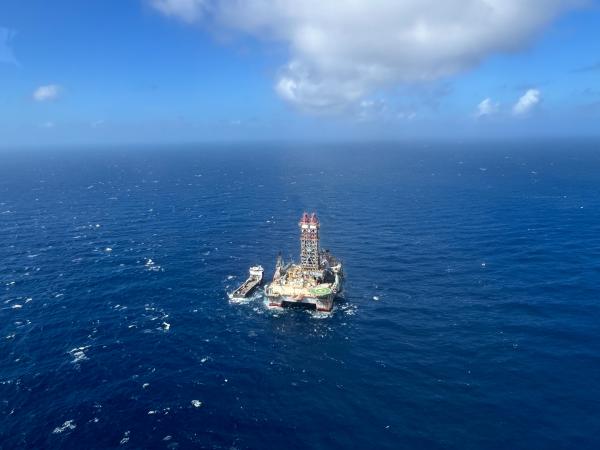The Ministry of Mines and Energy presented thea declaration of natural gas production for 2024 – 2025 which reveals a series of worrying data for the country in the coming months. This raises the question need to make decisions quickly to avoid supply shortages.
(Read: Changes in gas imports and sales proposed by the Government in response to deficit alert)
The data on the country’s production potential presented by the portfolio show a drop compared to what was reported last year. Luz Stella Murgas, president of Naturgás, pointed out that in fact the The potential presented for 2025 fell by 6% and that for 2026 decreased by 5% compared to what had been presented the previous year.
Not only that, but the Ministry’s data shows that the average output this year would be 1,019 GBTU (British Thermal Units) per day, while the average production will be 1,028 GBTUD.
In a few months, production versus demand will create difficulties. In fact, in recent days Rodolfo Anaya, president of Vanti, called attention to the hiring that will open in December to cover the agreements that expire this year, whose prices will be on the rise.
(You may be interested in: Moody’s warns of the need to diversify the electricity matrix and the effects of not acting)
Now, with the pressure of a lower availability of natural gas to cover demand, several situations could occur, such as users being left without coverage and the prices increase.
According to an analysis by the Colombian Oil and Gas Association (ACP), There is a shortage of between 100 and 130 GBTUD by 2025 of local production to cover user needs.
Considering that the average demand for next year is 1,033 GBTU per day, compared to an average local production of 897 GBTUDthis gives a shortfall equivalent to 13%, although it could vary.
This deficit would go “permanently increasing if no action is takenthat stimulate exploration and Development of contingent resources both onshore and offshore“Frank Pearl explained, president of the guild.
(We recommend: Creg: Government presented Fanny Guerrero’s resume to be an expert commissioner)
This situation has already been highlighted by the Government and by Ecopetrol, which has already presented a series of actions with the aim of addressing this situation, which could even lead to a shortage.
Ricardo Roa, president of the hydrocarbon company, said they are seeking to provide an additional 61 GBTUD through local sources, although they are also analyzing import options, which could quickly put molecules on the market.
(Also: What explains the increased oil production? There are two fields contributing to the data)
Uchuva 2 drilling platform
Ecopetrol
In this sense, the company analyzes the possibilities to supply gas from Venezuela, through the Antonio Ricaurte gas pipeline, as well as a regasification infrastructure.
He specifically reported that a new one has already been launchedn Information Request process to the market, with which it sought to understand the alternatives of receipt, storage and regasification energy sector. The company has already received expressions of interest from companies in this process.
This process will close in the last week of July, meaning that a contract for the import of liquefied natural gas could be signed in the second half of this year.
(Read also: Ghost of gas deficit: this is how they propose to address the shortage by 2025)
Both Murgas and Pearl agreed on the fact that it is necessary flandto facilitate commercial conditions that enable the exchange of this energy source. Among the aspects that could be adjusted to increase the volume of energy are the “duration of contracts, direct negotiations at any time of the year, signing of firm supply contracts with short, medium and long-term validity and flexibility in the start of contract execution“Murgas explained.
According to Pearl, this flexibility should be extended to all producing fields, both onshore and offshore, which would also allow for financial leverage for the projects.
In addition to this, the requests also have to do with aspects of the physical infrastructure transport. Murgas asked that the regulations be approved Investments associated with the expansion of the transport capacity of the Barranquilla – Ballena gas pipeline “which would allow the transport of surplus gas from the Atlantic Coast to the interior of the country”.
(Recommended: Ecopetrol and Petrobras announced drilling of the Uchuva 2 well in the offshore Caribbean)
Pearl also made a call on this issue, asking for an “adequate and sufficient” flow to the interior.
The ACP president pointed out that it is also required move forward in the way transportation through gas pipelines is remuneratedas well as making adjustments to how new pipelines are built.
“These measures must be considered urgent and a priority to avoid risks of shortages that affect the stability and competitiveness of the country.“Pearl said.
(Of interest: Lack of gas in Colombia has companies on the brink of an energy crisis)

Gas import
PHOTO: iStock
Given this situation of natural gas shortages, the unions highlighted the need for boost local exploratory activitywhich would allow more molecules to be put on the market. Pearl said that measures were needed to stimulate the development of gas fields from a contractual perspective.
Specifically, in this regard, Murgas highlighted that it is required “the Relaxation of the commitments required to extend deadlines and retain areas under evaluation; review the extension of existing contract areas affected by force majeure or technical aspects; resume the nomination of exclusive areas for natural gas in the country; and the promotion of synergies between conventional and energy transition projects”.
(Also: Gas reserves fell to 6.1 years and oil to 7.1 years in 2023, according to the ANH)
Specifically, the ACP report ‘Towards natural gas self-sufficiency in Colombia’ presented at the beginning of the year showed that There was an availability of gas, which is trapped for regulatory reasons, availability of facilities and infrastructure and environmental aspects. This analysis showed that public policy could enable the entry of these volumes.
The analysis showed that this is about 250 million cubic feet per day, which is about 25% of current demand. Modifications to tariff charges, the flexibility of the commercial framework and changes in the transportation tariff methodology would allow for the installation of 50 million cubic feet per day.
Daniela Morales Soler
Portfolio Journalist















Add Comment